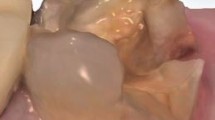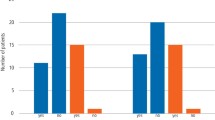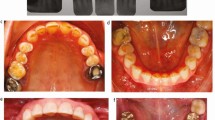Key Points
-
Class V cavities are multifactorial in origin.
-
Practitioners are faced with a multitude of possible restorative materials and techniques from which to choose.
-
General dental practitioners need guidance as to which material is the most effective for restoring Class V cavities.
-
Practice-based research provides evidence derived from real-life situations.
Abstract
Objective Evidence on the survival of different restorations in general practice is scarce and so to address this need, a study was designed to monitor the outcome of Class V restorations placed in UK general practices.
Design Prospective longitudinal cohort multi-centre study.
Setting UK general dental practice.
Materials and methods Ten UK dentists each placed 100 Class V restorations and recorded selected clinical information at placement and at recall visits on record cards. Dentists selected materials and techniques which they felt appropriate to each clinical situation.
Results Data cards for 11 restorations were incorrectly completed or information was missing leaving 989 for analysis. The majority of restorations were placed in patients between 51 and 60 years of age, in canines or premolars (68.4%) and under private contract (63%). Composite (40.85%) and compomer (23.46%) were the most frequently placed materials overall but were not the most frequently placed restorative by some dentists.
Conclusions Different dentists use different methods to manage Class V lesions but each dentist tends to use one restorative material predominantly. There is a degree of overlap among practitioners in the materials which they employ, but clear preferences were displayed in the materials used and handling techniques.
Similar content being viewed by others
Log in or create a free account to read this content
Gain free access to this article, as well as selected content from this journal and more on nature.com
or
References
Bortolotto T, Ferrari M, Tay F, Krejci I . Degradation of thermo-mechanically loaded adhesive class V restorations after 18 months of water storage. Am J Dent 2007; 20: 83–89.
Li Q, Jepsen S, Albers HK, Eberhard J . Flowable materials as an intermediate layer could improve the marginal and internal adaptation of composite restorations in class V cavities. Dent Mater 2006; 22: 250–257.
Yaman SD, Sahin M, Aydin C . Finite element analysis of strength characteristics of various resin based restorative materials in Class V cavities. J Oral Rehabil 2003; 30: 630–641.
Pollington S, van Noort R. A clinical evaluation of a resin composite and a compomer in non-carious Class V lesions. A 3-year follow-up. Am J Dent 2008; 21: 49–52.
Folwaczny M, Loher C, Mehl A, Kunzelmann KH, Hinkel R . Tooth-colored filling materials for the restoration of cervical lesions: a 24-month follow-up study. Oper Dent 2000; 25: 251–258.
Ermis RB. Two-year clinical evaluation of four polyacid-modified resin composites and a resin-modified glass-ionomer cement in class V lesions. Quintessence Int 2002; 33: 542–548.
Onal B, Pamir T . The two-year clinical performance of esthetic restorative materials in noncarious cervical lesions. J Am Dent Assoc 2005; 136: 1547–1555.
Levitch LC, Bader J D, Shugars D A, Heymann H O . Non-carious cervical lesions. J Dent 1994; 22: 195–207.
Grippo JO, Simring M, Schreiner S . Attrition, abrasion, corrosion and abfraction revisited: a new perspective on tooth surface lesions. J Am Dent Assoc 2004; 135: 1109–1118.
Peumans M, Kanumilli P, De Munck J, Van Landuyt K, Lambrechts P, Van Meerbeek B . Clinical effectiveness of contemporary adhesives: a systematic review of current clinical trials. Dent Mater 2005; 21: 864–881.
Mjor IA, Wilson N H . General dental practice: the missing link in dental research. J Dent Res 1997; 76: 820–821.
Mjor IA. Practice-based dental research. J Oral Rehabil 2007; 34: 913–920.
Wilson AD, Paddon J M . Dimensional changes occurring in a glass-ionomer cement. Am J Dent 1993; 6: 280–282.
Silness J, Loe H . Periodontal disease in pregnancy II. Correlation between oral hygiene and periodontal condtion. Acta Odontol Scand 1964; 22: 121–135.
Acknowledgements
This work was supported by a grant from the Shirley Glasstone Hughes Memorial Fund.
Author information
Authors and Affiliations
Corresponding author
Additional information
Refereed paper
Rights and permissions
About this article
Cite this article
Stewardson, D., Thornley, P., Bigg, T. et al. The survival of Class V restorations in general dental practice. Part 1, baseline data. Br Dent J 208, E17 (2010). https://doi.org/10.1038/sj.bdj.2010.445
Accepted:
Published:
Issue date:
DOI: https://doi.org/10.1038/sj.bdj.2010.445
This article is cited by
-
Evaluation of low-viscosity bulk-fill composites regarding marginal and internal adaptation
Odontology (2021)
-
The survival of Class V restorations in general dental practice: part 3, five-year survival
British Dental Journal (2012)
-
The survival of Class V restorations in general dental practice. Part 2, early failure
British Dental Journal (2011)
-
Summary of: The survival of Class V restorations in general dental practice. Part 2, early failure
British Dental Journal (2011)
-
Summary of: The survival of Class V restorations in general dental practice. Part 1, baseline data
British Dental Journal (2010)



